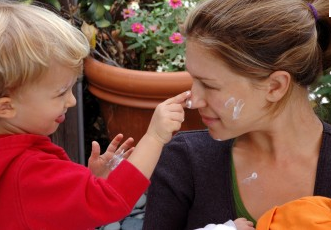Summer Sunscreen Tips for Parents

Anyone who reads my blog knows that while my business focuses on marketing to women, I’m also a mom and by nature like to share news and information with those around me. In addition, from years of baking in the sun with baby oil and iodine, I’m also in a continual battle to identify and destroy the first signs of basal cell carcinomas that are beginning to pop up on my body with increasing frequency.
Compared to earlier generations, baby boomers have had heavier doses of UV exposure because being tan was fashionable in our teens and 20’s. And though as a generation we’ve become more diligent about protecting our skin, the fact is that most sun damage is done in childhood and adolescence.
This summer many moms may not be aware that the FDA just announced new guidelines for sunscreen effectiveness and labeling. In light of this news, I wanted to share some tips provided by Episencial’s CEO and chief product formulator Kim Walls to ensure that you and your families have the latest information on sun care, and the safest of summers this season.
- Learn how to read the label on any sunscreen product. Opt for chemical-free products that offer full spectrum protection, protecting against both the UVA and UVB rays. The FDA really focused on this point and is strongly recommending broad-spectrum products – those that screen both UVA and UVB sunrays.
- The best Sun Protection Factor (SPF) level for your child depends on what you will be doing. Chose a sunscreen with a minimum SPF of 35, which will protect more than 95 percent of the harmful wavelength of UV rays – just right for playing at the beach, park or in the backyard.
- A natural mineral (aka physical) block is, by far, the safest sunscreen option. Zinc sits on the skin’s surface to reflect sunrays away from the body like a mirror, as opposed to chemical ingredients, which are designed to be absorbed into the skin and can have potentially unintended and harmful consequences for children’s skin and body.
- In addition to preventing sun damage, it’s also important to combat the negative effects of increased exposure to pollution in the ocean and air and also by the sheer heat on the skin’s surface. Products that contain aloe help cool the skin. Ingredients like green tea extract offset skin problems and help prevent lasting damage from sun exposure.
- The skin’s ability to perform essential immune functions can be compromised by the damaging dryness resulting from exposure to chlorine from pools and typical city water supplies. Sunscreens that are all natural and fortified with ingredients such as Vitamin C, organic oils such as avocado, beeswax, Shea butter offset chlorine, maintain skin hydration and create a water-resistant barrier to reduce absorption of pollutants through the skin to support overall health.
For more information about sunscreen or skincare, ask Kim on Facebook at www.facebook.com/episencial.
